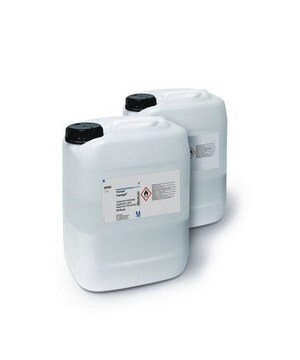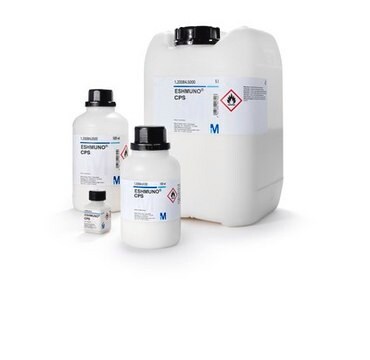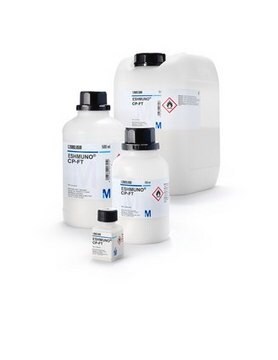推荐产品
ligand
(Sulfoisobutyl)
品質等級
100
400
描述
strong cation exchanger, suspension in 20% ethanol and 150 mM NaCl (20-40 µm)
無菌
sterile (Caustic Stable)
化驗
≥90% (HPLC)
形狀
resin
製造商/商標名
Calbiochem®
參數
8 bar max. pressure
80 cm/hr flow rate
基質活性組
methacrylate
平均粒徑
20-40 um μm
容量
150 mg binding capacity (lysozyme/ml of resin)
轉變溫度
flash point 35 °C (Does not sustain combustion.)
密度
1.43 g/cm3 at 20 °C
體積密度
1000 kg/m3
分離技術
strong cation exchange
運輸包裝
ambient
儲存溫度
2-8°C
正在寻找类似产品? 访问 产品对比指南
包裝
- 1.16882.0100: Fractogel® EMD SO3- (S) Resin 100ml
- 1.16882.0010: Fractogel® EMD SO3- (S) Resin 10ml
- 1.16882.0500: Fractogel® EMD SO3- (S) Resin 500ml
- 1.16882.5000: Fractogel® EMD SO3- (S) Resin 5L
警告
Toxicity: Standard Handling (A)
分析報告
Appearance: Milky turbid suspension, free from impurities (foreign particles)
Microscopic evaluation: Uniform spherical particles,no agglomerates,no fines
Extractable matter (water): ≤ 0.05 %
Cerium: ≤ 10 µg/g
Pressure drop(column: ID=1.6 cm, L=10 cm at 5 ml/min): ≤ 5.0 bar
Particle size (d10): 20 - 28 µm
Particle size (d50): 24 - 34 µm
Particle size (d90): 28 - 38 µm
Colony forming units (TAMC + TYMC): ≤ 100 CFU/ml
Endotoxins: ≤ 1.00 EU/ml
Protein binding capacity (lysozyme): 120 - 180 mg/ml
Functional test (c:d): ≤ 0.15
Functional test (b:a): ≤ 0.15
Functional test: Separation chymotrypsinogen A, cytochrom C and lysozyme
Microscopic evaluation: Uniform spherical particles,no agglomerates,no fines
Extractable matter (water): ≤ 0.05 %
Cerium: ≤ 10 µg/g
Pressure drop(column: ID=1.6 cm, L=10 cm at 5 ml/min): ≤ 5.0 bar
Particle size (d10): 20 - 28 µm
Particle size (d50): 24 - 34 µm
Particle size (d90): 28 - 38 µm
Colony forming units (TAMC + TYMC): ≤ 100 CFU/ml
Endotoxins: ≤ 1.00 EU/ml
Protein binding capacity (lysozyme): 120 - 180 mg/ml
Functional test (c:d): ≤ 0.15
Functional test (b:a): ≤ 0.15
Functional test: Separation chymotrypsinogen A, cytochrom C and lysozyme
法律資訊
CALBIOCHEM is a registered trademark of Merck KGaA, Darmstadt, Germany
FRACTOGEL is a registered trademark of Merck KGaA, Darmstadt, Germany
訊號詞
Warning
危險聲明
危險分類
Flam. Liq. 3
儲存類別代碼
3 - Flammable liquids
水污染物質分類(WGK)
WGK 1
閃點(°F)
95.0 °F
閃點(°C)
35 °C
D L Boyle et al.
The Journal of pharmacology and experimental therapeutics, 296(2), 495-500 (2001-02-13)
Adenosine (ADO) is a homeostatic inhibitory autocoid that is released at sites of inflammation and tissue injury, and exerts anti-inflammatory effects via multiple interactions at ADO receptor subtypes. Inhibition of ADO kinase (AK) increases extracellular ADO concentrations and AK inhibitors
E A Kowaluk et al.
The Journal of pharmacology and experimental therapeutics, 295(3), 1165-1174 (2000-11-18)
Adenosine kinase (AK; EC 2.7.1.20) is a key intracellular enzyme regulating intra-and extracellular concentrations of adenosine (ADO), an endogenous neuromodulator, antinociceptive, and anti-inflammatory autocoid. AK inhibition provides a means of potentiating local tissue concentrations of endogenous ADO, and AK inhibitors
R Suzuki et al.
British journal of pharmacology, 132(7), 1615-1623 (2001-03-27)
1. Adenosine (ADO) receptor activation modulates sensory transmission in the dorsal horn. Little is known about the circumstances underlying release of the purine. The present study was conducted to investigate the effect of a novel and potent non-nucleoside adenosine kinase
Jean De Vry et al.
European journal of pharmacology, 491(2-3), 137-148 (2004-05-14)
The chronic constriction injury model is a rat model of neuropathic pain based on a unilateral loose ligation of the sciatic nerve. The aim of the present study was to test its sensitivity to various clinically validated and experimental drugs.
M F Jarvis et al.
The Journal of pharmacology and experimental therapeutics, 295(3), 1156-1164 (2000-11-18)
Adenosine (ADO) is an inhibitory neuromodulator that can increase nociceptive thresholds in response to noxious stimulation. Inhibition of the ADO-metabolizing enzyme adenosine kinase (AK) increases extracellular ADO concentrations at sites of tissue trauma and AK inhibitors may have therapeutic potential
我们的科学家团队拥有各种研究领域经验,包括生命科学、材料科学、化学合成、色谱、分析及许多其他领域.
联系技术服务部门



